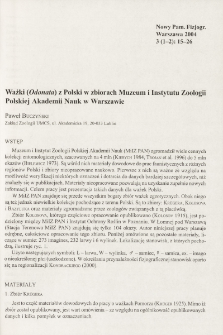- Search in all Repository
- Literature and maps
- Archeology
- Mills database
- Natural sciences
Advanced search
Advanced search
Advanced search
Advanced search
Advanced search

Object
Title: Ważki (Odonata) z Polski w zbiorach Muzeum i Instytutu Zoologii Polskiej Akademii Nauk w Warszawie
Subtitle:
Ważki (Odonata) z Polski ; Dragonflies (Odonata) from Poland in the collection of Museum and Institute of Zoology of Polish Academy of Sciences in Warsaw
Publisher:
Place of publishing:
Description:
Abstract:
In the Museum and Institute of Zoology of Polish Academy of Sciences (MilZ PAN) there are five collections of dragonflies from the area of Poland. In this paper the four of them are discussed: the materials of Kruger from Szczecin Coastline and Baltic Coastline (1913-21) - the part of the evidence collection for the paper of the dragonflies of Pomorze (Kruger 1925); 2) the materials of Bazyluk from Siemień vicinity in Western Polesie (1929-50), the majority was published by Bazyluk (1947, 2002) and Buczyński (2003); 3) unpublished materials of the group of hydrobiologists from MilZ PAN from the Srodkowomazowiecka Lowland (1954-55); 4) unpublished materials from 12 regions in different part of the country, collected by researchers of MilZ PAN (1945-50). The localization of sites, where materials were collected, are presen- ted in Fig. 1. The discussed collections encompass 46 species. The most interesting are: Sympecma paedisca, Aeshna affinis, Orthetrum albistylum and Sympetrum fonscolombii. Nowadays five are under protection (Sympecma paedisca, Ophiogomphus cecilia, Aeshna viridis, Leucorrhinia al- bifrons, L. pectoralis), four are redlisted (Nehalennia speciosa, Aeshna affinis,A. viridis, Leucorrhinia albifrons). The specimens of Sympecma paedisca from Kruger’s collections are the oldest evidence of the presence of this species in north-western Poland. They were published as S.fusca. This is another example of wrong Identification of this species (cf. Buczyński 2003). It shows that the part of older records of S. fusca probably refers to S. paedisca. The revision of evidence collections could be helpful in defining the boundaries of the rangę of this species in Central and Eastem Europę. Zaborów near Warszawa had been the third locality of Orthetrum albistylum in Poland outside its compact before its boundary moved towards north-west during its expansion in the second half of 90s in 20,h century. Interesting, although not changing the whole picture of their distributions, are the records of Aeshna affinis and Sympetrum fonscolombii. Particularly in the latter case the increase in number of finds has been observed in recent years but without moving the boundaries of its rangę (Fig. 2). Analysed collections are a valuable complement of knowledge about some regions because they come from poorly studies areas and the times when odonatological studies were scarce. The most valuable are materials form central and middle-eastem Poland
Relation:
Nowy Pamiętnik Fizjograficzny, t. 3, z. 1/2 (2004)
Volume:
Issue:
Start page:
End page:
Resource Identifier:
oai:rcin.org.pl:235488 ; ISSN 1643-8965
Source:
Language:
Language of abstract:
Rights:
Creative Commons Attribution BY 3.0 PL license
Terms of use:
Copyright-protected material. [CC BY 3.0 PL] May be used within the scope specified in Creative Commons Attribution BY 3.0 PL license, full text available at: ; -
Digitizing institution:
Museum and Institute of Zoology of the Polish Academy of Sciences
Original in:
Library of the Museum and Institute of Zoology PAS
Access:
Object collections:
- Digital Repository of Scientific Institutes > Partners' collections > Museum and Institute of Zoology PAS > Scientific Journals
- Digital Repository of Scientific Institutes > Literature > Journals/Articles
Last modified:
Jul 7, 2022
In our library since:
Jun 7, 2022
Number of object content downloads / hits:
104
All available object's versions:
https://rcin.org.pl./publication/271591
Show description in RDF format:
Show description in RDFa format:
Show description in OAI-PMH format:
| Edition name | Date |
|---|---|
| P. Buczyński - Ważki (Odonata) z Polski w zbiorach Muzeum i Instytutu Zoologii Polskiej Akademii Nauk w Warszawie | Jul 7, 2022 |
Objects Similar
Buczyński, Paweł
Bernard, Rafał Buczyński, Paweł Tończyk, Grzegorz
Mielewczyk, Stefan (1933–2005)
Mielewczyk, Stefan (1933–2005)
Bernard, Rafał Buczyński, Paweł Łabędzki, Andrzej Tończyk, Grzegorz
Sumiński, Stanisław Michał (1891–1943)
Buczyński, Paweł

 INSTYTUT ARCHEOLOGII I ETNOLOGII POLSKIEJ AKADEMII NAUK
INSTYTUT ARCHEOLOGII I ETNOLOGII POLSKIEJ AKADEMII NAUK
 INSTYTUT BADAŃ LITERACKICH POLSKIEJ AKADEMII NAUK
INSTYTUT BADAŃ LITERACKICH POLSKIEJ AKADEMII NAUK
 INSTYTUT BADAWCZY LEŚNICTWA
INSTYTUT BADAWCZY LEŚNICTWA
 INSTYTUT BIOLOGII DOŚWIADCZALNEJ IM. MARCELEGO NENCKIEGO POLSKIEJ AKADEMII NAUK
INSTYTUT BIOLOGII DOŚWIADCZALNEJ IM. MARCELEGO NENCKIEGO POLSKIEJ AKADEMII NAUK
 INSTYTUT BIOLOGII SSAKÓW POLSKIEJ AKADEMII NAUK
INSTYTUT BIOLOGII SSAKÓW POLSKIEJ AKADEMII NAUK
 INSTYTUT CHEMII FIZYCZNEJ PAN
INSTYTUT CHEMII FIZYCZNEJ PAN
 INSTYTUT CHEMII ORGANICZNEJ PAN
INSTYTUT CHEMII ORGANICZNEJ PAN
 INSTYTUT FILOZOFII I SOCJOLOGII PAN
INSTYTUT FILOZOFII I SOCJOLOGII PAN
 INSTYTUT GEOGRAFII I PRZESTRZENNEGO ZAGOSPODAROWANIA PAN
INSTYTUT GEOGRAFII I PRZESTRZENNEGO ZAGOSPODAROWANIA PAN
 INSTYTUT HISTORII im. TADEUSZA MANTEUFFLA POLSKIEJ AKADEMII NAUK
INSTYTUT HISTORII im. TADEUSZA MANTEUFFLA POLSKIEJ AKADEMII NAUK
 INSTYTUT JĘZYKA POLSKIEGO POLSKIEJ AKADEMII NAUK
INSTYTUT JĘZYKA POLSKIEGO POLSKIEJ AKADEMII NAUK
 INSTYTUT MATEMATYCZNY PAN
INSTYTUT MATEMATYCZNY PAN
 INSTYTUT MEDYCYNY DOŚWIADCZALNEJ I KLINICZNEJ IM.MIROSŁAWA MOSSAKOWSKIEGO POLSKIEJ AKADEMII NAUK
INSTYTUT MEDYCYNY DOŚWIADCZALNEJ I KLINICZNEJ IM.MIROSŁAWA MOSSAKOWSKIEGO POLSKIEJ AKADEMII NAUK
 INSTYTUT PODSTAWOWYCH PROBLEMÓW TECHNIKI PAN
INSTYTUT PODSTAWOWYCH PROBLEMÓW TECHNIKI PAN
 INSTYTUT SLAWISTYKI PAN
INSTYTUT SLAWISTYKI PAN
 SIEĆ BADAWCZA ŁUKASIEWICZ - INSTYTUT TECHNOLOGII MATERIAŁÓW ELEKTRONICZNYCH
SIEĆ BADAWCZA ŁUKASIEWICZ - INSTYTUT TECHNOLOGII MATERIAŁÓW ELEKTRONICZNYCH
 MUZEUM I INSTYTUT ZOOLOGII POLSKIEJ AKADEMII NAUK
MUZEUM I INSTYTUT ZOOLOGII POLSKIEJ AKADEMII NAUK
 INSTYTUT BADAŃ SYSTEMOWYCH PAN
INSTYTUT BADAŃ SYSTEMOWYCH PAN
 INSTYTUT BOTANIKI IM. WŁADYSŁAWA SZAFERA POLSKIEJ AKADEMII NAUK
INSTYTUT BOTANIKI IM. WŁADYSŁAWA SZAFERA POLSKIEJ AKADEMII NAUK


































